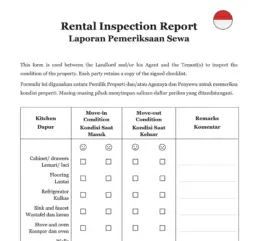Understanding Rental Property Checklist Standards
Maintaining a rental property involves adhering to various checklist standards that ensure safety, habitability, and overall property condition. A comprehensive rental property checklist helps property owners identify and address issues proactively, ensuring compliance with local regulations and maintaining tenant satisfaction. This guide will outline the essential steps for ensuring compliance with rental property checklist standards.
For property owners looking to simplify this process, our rental inspection report template is an invaluable tool. It ensures all necessary details are covered, helping you maintain compliance effortlessly.
Identifying Key Rental Property Checklist Standards
To ensure your rental property meets required standards, it’s important to understand what these standards entail. Rental property checklist standards typically cover aspects such as safety, habitability, and maintenance. These checklists help property owners identify issues that could affect the health and safety of tenants, as well as the overall condition of the property.
Key Areas Covered by Checklists
Subleasing is essentially a secondary lease agreement between the original tenant and a new tenant, or subtenant. The original lease between the property owner and the tenant remains in effect, making the original tenant responsible for the property and ensuring rent payments. The subtenant pays rent to the original tenant, not directly to the property owner.
1. Safety: Ensuring the property is free from hazards such as faulty wiring, structural issues, and fire risks.
2. Habitability: Verifying that the property has adequate heating, plumbing, and sanitation facilities.
3. Maintenance: Checking for general wear and tear, ensuring that appliances and fixtures are in good working order.
Understanding these standards is the first step towards compliance. A detailed checklist helps property owners systematically inspect their properties and address any deficiencies.
Conducting Regular Inspections to Comply with Rental Property Checklist Standards
Regular inspections are crucial for maintaining compliance with rental property checklist standards. Inspections should be conducted at key points during the rental cycle, including move-in, move-out, and periodic checks throughout the tenancy.
Move-In and Move-Out Inspections
| ➤ Move-In Inspections: Conduct a thorough inspection before a new tenant moves in. Document the condition of the property and have the tenant sign off on the inspection report to acknowledge the property's state. This initial inspection helps set clear expectations and serves as a reference for future inspections. |
| ➤ Move-Out Inspections: Perform an inspection when the tenant moves out to assess any damage or changes in the property's condition. This helps determine whether any deductions from the security deposit are necessary. By comparing the move-in and move-out inspection reports, you can accurately assess any tenant-caused damage beyond normal wear and tear. |
Periodic Inspections
| ➤ Routine Checks: Schedule regular inspections, such as quarterly or biannually, to ensure ongoing compliance with standards. These inspections help identify and address issues before they escalate, ensuring the property remains in good condition throughout the tenancy. Regular inspections can also help foster a positive relationship with tenants, showing them that you are committed to maintaining the property. |
Addressing Maintenance Issues Promptly to Meet Property Checklist Standards
Timely maintenance is essential for compliance with rental property checklist standards and for ensuring tenant satisfaction. Addressing maintenance issues promptly not only prevents small problems from becoming major repairs but also ensures the property remains in good condition and complies with checklist standards.
Common Maintenance Issues
1. Plumbing Problems: Fix leaks, clogs, and other plumbing issues immediately to prevent water damage and ensure proper sanitation. Regularly inspect pipes, faucets, and drains to catch potential issues early.
2. Electrical Issues: Regularly inspect electrical systems to ensure safety and prevent fire hazards. This includes checking outlets, switches, and wiring for any signs of wear or damage.
3. General Wear and Tear: Keep up with routine maintenance tasks such as painting, carpet cleaning, and appliance servicing. Regular maintenance helps maintain the property’s appearance and functionality, making it more attractive to current and potential tenants.
Benefits of Prompt Maintenance
1. Tenant Satisfaction: Addressing maintenance issues quickly shows tenants that you care about their well-being and comfort, which can lead to higher tenant retention rates.
2. Cost Savings: Preventive maintenance can save money by addressing issues before they become costly repairs. Regular upkeep helps extend the life of the property’s fixtures and appliances.
3. Compliance: Keeping up with maintenance ensures that your property remains in compliance with safety and habitability standards, reducing the risk of legal issues.
Keeping Accurate Records for Property Checklist Standards
Accurate record-keeping is vital for maintaining compliance with rental property checklist standards and protecting your investment. By documenting inspection findings, maintenance activities, and tenant communications, you create a detailed history of your property’s condition and the actions taken to address any issues. This comprehensive documentation not only helps ensure that your property meets all regulatory requirements but also provides valuable evidence in case of disputes.
ℹ️ To enhance your record-keeping, utilize our rent receipt template to accurately track and document rental payments.
Screening Subtenants for Compliance and Suitability
Thoroughly screening subtenants is essential to ensure they meet your property standards and are financially reliable. This process involves background and credit checks, verifying employment, and assessing rental history. A detailed screening helps prevent potential issues and ensures a smooth subleasing experience.
For a more streamlined approach, refer to our guide on finding the perfect tenants and utilize our rental application template. These resources provide effective tools for managing tenant and subtenant selection, ensuring a successful and hassle-free rental arrangement.
Ask your question and receive legal advice from a qualified lawyer
310 client reviews (4.8/5) ⭐⭐⭐⭐⭐











